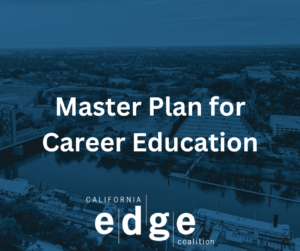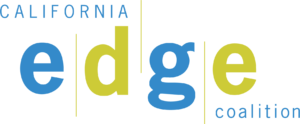 On April 2nd, Governor Newsom unveiled the Master Plan for Career Education. The Master Plan proposes to create a more inclusive workforce by acknowledging that while traditional four-year degrees remain valuable, they are not the sole pathway to well-paying, fulfilling careers. The Master Plan provides 6 focus areas that seek to align and strengthen our state’s education and workforce systems and better support underserved Californians, while also uplifting key initiatives that are currently underway. View our highlights of the Master Plan below, which also includes items that uplift EDGE’s recommendations.
On April 2nd, Governor Newsom unveiled the Master Plan for Career Education. The Master Plan proposes to create a more inclusive workforce by acknowledging that while traditional four-year degrees remain valuable, they are not the sole pathway to well-paying, fulfilling careers. The Master Plan provides 6 focus areas that seek to align and strengthen our state’s education and workforce systems and better support underserved Californians, while also uplifting key initiatives that are currently underway. View our highlights of the Master Plan below, which also includes items that uplift EDGE’s recommendations.
Read the full Master Plan report here.
Stay tuned for more updates as the legislative session continues.
Master Plan for Career Education – Highlights
1. Create a State Planning and Coordinating Body
- The statewide body will bring together the state’s education segments, workforce training providers, and employers with the mission to assess economic and skill needs, set goals, align plans, maximize funding, design and implement programs, and support regional efforts.
- Currently, there’s pending trailer bill language to establish a council.
2. Strengthen Regional Coordination
- Given the various regional entities that already exist, like the High Road Training Partnerships, K-16 Collaboratives, CA Jobs First, etc., the Master Plan calls for an assessment of successful regional coordination models to identify ways to scale and sustain forums where educators, workforce training providers, and employers collaborate with clearly defined roles and responsibilities in order for better coordination across regional efforts and while reducing duplication efforts.
3. Support Skills-Based Hiring Through a Career Passport
- The creation of a Career Passport is intended to offer verified academic records and confirmation of mastered competencies from a trusted third party. The goal is for state agencies and higher education institutions to help employers make hiring decisions based not only on academic credentials but also demonstrated skills. A validated skills framework, like a Career Passport, enables employers to advance skills-based hiring and helps colleges award credit for proven competencies.
4. Develop Career Pathways for High School and College Students
- The Master Plan calls for making pathways programs universally available to give students of all backgrounds clear routes to good jobs and career growth. Starting in high school, all students should be encouraged to explore rewarding, long-term careers—whether or not they require a college degree—and guided toward clear pathways to pursue them. For instance, providing students with dual enrollment, apprenticeships, and work-based learning opportunities so they can further explore their career options.
5. Strengthen Workforce Training for Young People and Adults
- The Master Plan uplifts the importance of supporting opportunity youth – 16–24-year-old population who have been disconnected from our education and workforce systems and who often face challenges like homelessness, involvement with the justice system or foster care. The Master Plan calls education and workforce agencies to ensure that opportunity youth and adults needing skills training can access education, job training, and employment that lead to stable, well-paying career pathways.
- This includes enhancing credit for prior learning and competency-based education pathways.
- Leverage job centers, community colleges, adult schools, libraries, correctional facilities, and community organizations to build an affordable, “no wrong door” system for education and workforce training.
- Sector-based pathways that meet worker and youth needs, use cohorts, and offer work-based and earn-and-learn opportunities can strengthen coordination between training programs and community colleges.
6. Increase Access to and Affordability of Education and Workforce Training
- The Master Plan calls for state agencies and higher education institutions to ensure all learners, regardless of background or location, can easily access education, training, and public benefits that lead to better, higher-paying jobs.
- Specifically, by improving awareness of and access to public benefits, state agencies and higher education institutions can help eligible students cover non-tuition costs.
- Streamlining eligibility and leveraging federal workforce funds can further support adult learners in paying for college.
- Collaborating with employers, education and training providers can also expand access to earn-and-learn opportunities like apprenticeships, paid internships, and service learning.
Thus far, the statewide interagency council, career passport, and credit for prior learning initiatives have proposed funding in the 2025-26 state budget, with trailer bill language.
The Master Plan for Career Education is meant to be a living document, adapting to California’s constantly evolving needs, and will serve as a blueprint for the work ahead.
For questions, please contact Jason Henderson, Policy Analyst, at jhenderson@caedge.org.
